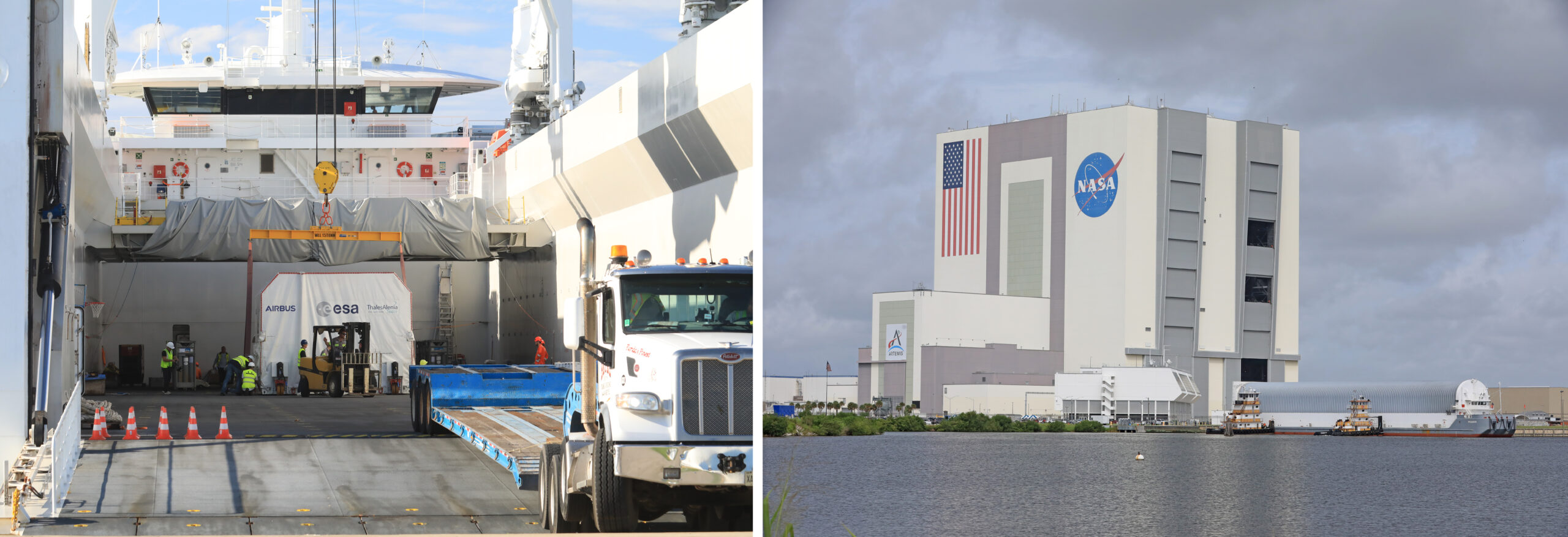Key Components for Artemis Moon Missions Arrive at NASA Kennedy Space Center
NASA’s Artemis program is making significant strides towards its goal of returning humans to the Moon and eventually embarking on missions to Mars. Recently, two ships traveled across the Atlantic Ocean and through the Gulf of Mexico to deliver essential spacecraft and rocket components to NASA’s Kennedy Space Center in Florida. This marks a crucial milestone in the Artemis campaign, particularly for the upcoming Artemis III mission.
On September 3rd, the European Space Agency (ESA) celebrated a significant achievement as the European-built service module for NASA’s Orion spacecraft completed a transatlantic journey from Bremen, Germany, to Port Canaveral, Florida. Once there, technicians moved it to NASA Kennedy. This service module, transported aboard the Canopée cargo ship, was assembled by Airbus with components from ten European countries and the United States. It is designed to provide propulsion, thermal control, electrical power, and essential life support systems such as water and oxygen for the crew.
Amit Kshatriya, deputy associate administrator for the Moon to Mars Program at NASA Headquarters in Washington, emphasized the importance of this milestone. "Seeing multi-mission hardware arrive at the same time demonstrates the progress we are making on our Artemis missions,” Kshatriya said. “We are going to the Moon together with our industry and international partners, and we are manufacturing, assembling, building, and integrating elements for Artemis flights.”
NASA’s Pegasus barge, the agency’s reliable vessel for transporting large hardware by sea, also played a crucial role in delivering multi-mission hardware. The barge carried components for the Space Launch System (SLS) rocket, including the Artemis II launch vehicle stage adapter, the "boat-tail" of the core stage for Artemis III, the core stage engine section for Artemis IV, and ground support equipment necessary for assembling these large components. The barge docked at NASA Kennedy’s Launch Complex 39B Turn Basin on Thursday.
The spacecraft factory inside NASA Kennedy’s Neil Armstrong Operations and Checkout Building is set to become a hub of activity in the coming months. With the Artemis II Orion crew and service modules already stacked together and undergoing testing, engineers are now outfitting the Artemis III and IV crew modules. The newly arrived European Service Module will soon be connected to the crew module adapter, which houses electronic equipment for communications, power, and control. This adapter also includes an umbilical connector that links the electrical, data, and fluid systems between the crew and service modules.
The SLS rocket’s cone-shaped launch vehicle stage adapter plays a critical role in connecting the core stage to the upper stage. It also protects the rocket’s flight computers, avionics, and electrical devices during launch and ascent. This adapter will be moved to Kennedy’s Vehicle Assembly Building in preparation for Artemis II rocket stacking operations.
The boat-tail, a fairing-like structure, protects the bottom end of the SLS core stage and the RS-25 engines. This hardware, retrieved from NASA’s Michoud Assembly Facility in New Orleans, will join the Artemis III core stage engine section housed in the spaceport’s Space Systems Processing Facility. Similarly, the Artemis IV SLS core stage engine section, which also arrived from NASA Michoud, will be transferred to the center’s processing facility ahead of final assembly.
The Artemis campaign aims to achieve several groundbreaking goals, including landing the first woman, the first person of color, and an international partner astronaut on the lunar surface. This mission will not only establish long-term exploration for scientific discovery but also serve as a preparatory step for human missions to Mars. NASA’s SLS rocket and Orion spacecraft, along with supporting ground systems, the human landing system, next-generation spacesuits and rovers, and the Gateway, form the foundation for deep space exploration.
The Artemis program represents a collaborative effort between NASA and its international partners, including ESA. The European Service Module is a testament to this collaboration, showcasing the contributions of multiple countries towards a common goal. Airbus, the prime contractor for the service module, has brought together components from across Europe and the United States to create a vital piece of hardware for the Orion spacecraft.
The arrival of these components at Kennedy Space Center marks a significant step forward in the Artemis program. As the various elements are assembled and integrated, the anticipation for the upcoming Artemis missions continues to build. These missions will pave the way for a new era of human space exploration, taking us back to the Moon and beyond.
For those interested in the technical details, the European Service Module (ESM) is a critical part of the Orion spacecraft. It is responsible for providing the spacecraft with propulsion, power, and life support systems. The ESM includes solar arrays for generating electricity, tanks for storing water and oxygen, and engines for maneuvering in space. This module is essential for the survival and comfort of the astronauts during their mission.
The Space Launch System (SLS) rocket, on the other hand, is NASA’s most powerful rocket ever built. It is designed to carry astronauts and cargo to deep space destinations. The SLS rocket consists of a core stage, which houses the RS-25 engines, and an upper stage, which provides additional thrust to propel the spacecraft towards its destination. The launch vehicle stage adapter connects these two stages and protects the rocket’s sensitive electronics during launch.
The Pegasus barge, named after the mythological winged horse, is a specialized vessel used by NASA to transport large rocket components. It has been instrumental in moving hardware for the SLS rocket from manufacturing facilities to the launch site. The barge is designed to accommodate the massive size and weight of these components, ensuring their safe and efficient transport.
As the countdown to the Artemis missions continues, the excitement and anticipation are palpable. The successful delivery of these critical components is a testament to the dedication and hard work of the teams involved. With each milestone achieved, we move one step closer to returning humans to the Moon and embarking on the journey to Mars.
For more detailed information on NASA’s Artemis missions, you can visit the official Artemis website at https://www.nasa.gov/artemis. This website provides comprehensive information on the mission objectives, hardware, and the progress being made towards achieving these ambitious goals.
In summary, the recent arrival of key spacecraft and rocket components at NASA Kennedy Space Center marks a significant milestone in the Artemis program. This collaborative effort between NASA and its international partners, including ESA, is a testament to the power of teamwork and innovation. As the various elements are assembled and integrated, the Artemis missions will pave the way for a new era of human space exploration, taking us back to the Moon and beyond.
For more Information, Refer to this article.


































